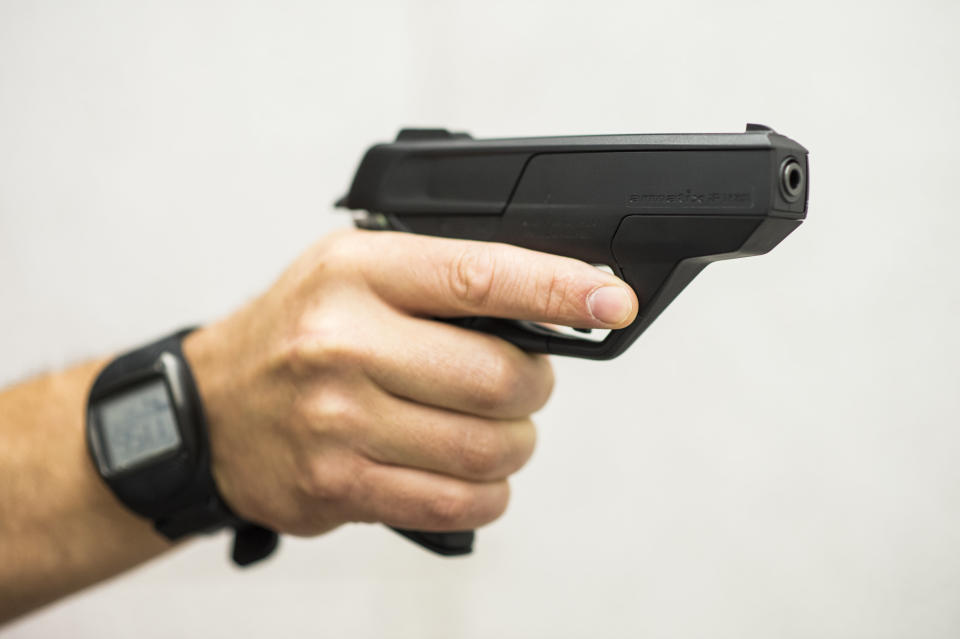Can A New Smart Gun Crack The Firearms Market?
Sometime in the next year, Philadelphia-based startup LodeStar Firearms says it will release the first commercially viable smart gun, a 9 mm semiautomatic handgun with a user-recognition lock designed to allow only authenticated users to fire it.
This sort of technology hasn’t caught on in the U.S., so it’s something of a gamble for LodeStar, which is raising $3 million in seed funding to finalize a prototype. The company is banking on being able to disrupt the firearms industry by capitalizing on an uncertain demand for gun safety features. If such advances prove popular, LodeStar says, it could lead to an industrywide evolution that would ultimately save thousands of lives each year.
LodeStar is still ironing out the specifications of its pistol; regardless of how it turns out, it won’t be the first or only smart gun on the U.S. market. Firearms manufacturers have been tinkering with personalized locking technology for decades, hoping to sell consumers on handguns that are resistant to misuse by children, thieves or assailants.
But smart guns have largely failed to break through, in part because of opposition from people who claim the technology will lead to bans on traditional firearms, with only more expensive and less reliable options allowed. Pro-gun groups have even boycotted companies that have pursued gun safety initiatives.
In 2014, German manufacturer Armatix released the iP1, a semiautomatic, .22-caliber handgun that initially retailed for about $1,800 ― as much as five times the going rate for some comparable traditional handguns. Included in that price is a watch required to activate the weapon, using radio-frequency identification (RFID).

LodeStar told HuffPost that it may use similar technology and that it’s also exploring an unspecified alternative. The company ruled out fingerprint technology, which Armatix reportedly utilizes in a new prototype. LodeStar CEO Gareth Glaser previously raised the possibility of a firearm that could be unlocked by a microchip implanted in a user’s hand.
The iP1 showed some promise but was widely criticized for its high cost, futuristic appearance and security vulnerabilities, and gun rights advocates said it would lead to a broad smart gun mandate. Very few gun stores offer the iP1, with some perhaps deterred by death threats against some early sellers.
LodeStar appears to have learned from the hurdles faced by Armatix and has started by focusing on price. This week LodeStar released the results of a study of gun-owning households that sought to identify how much they would be willing to pay for a reliable childproof smart gun. The survey found that the most respondents said they would shell out $795 ― about $300 more than a comparable conventional handgun. A price of $995 would maximize profit for LodeStar but result in fewer units sold, according to the study.
The company will aim for the $795 price tag in hopes of getting its smart guns into as many hands as possible, said Glaser.
“There’s certainly a large percentage of gun owners who would pay for the added safety,” said Glaser. “On top of that, we’re going to make sure that we have a technologically superior gun.”
LodeStar is reaching out to get large metropolitan police departments and other law enforcement agencies to field-test the handguns. LodeStar says it is leaning heavily on its board members Gil Kerlikowske (a former head of U.S. Customs and Border Protection and a two-term president of the Major Cities Chiefs Association) and John Diaz (a former Seattle police chief), who together have more than 70 years of law enforcement experience.
A 2017 survey showed some interest in smart gun technology among police, with many officers motivated by concerns about having their guns turned against them and their service weapons being lost or stolen. Smart guns could help address those issues. But if LodeStar wants to crack into the U.S. law enforcement market, which includes about 1 million law enforcement officers who carry firearms, it must first prove that its product is just as dependable as a standard police sidearm.
To encourage people to consider its alternative, the company has been following an aesthetic already familiar to police officers and gun owners, said Ralph Fascitelli, LodeStar’s chief marketing officer.

If police end up endorsing LodeStar’s handgun, it would likely help bridge a credibility gap with civilian consumers, where demand for smart guns remains uncertain. LodeStar cited a 2016 survey by the Johns Hopkins Bloomberg School of Public Health showing that nearly 60 percent of Americans polled said they would be willing to purchase a smart or childproof gun if they were going to buy a new firearm. But those findings contrasted sharply with a 2013 survey by a gun industry trade group that found that a majority of Americans surveyed said they were skeptical of smart guns and likely wouldn’t purchase them.
There’s not yet a clear consensus on smart guns, said Lacey Wallace, an assistant professor of criminal justice at Penn State Altoona who has studied the views of college students and the general public toward personalized firearms. She said results vary, depending on how questions are phrased and who is polled.
With about 30 percent of U.S. households owning guns ― and just 3 percent of American adults possessing nearly half of all civilian-owned firearms ― Wallace cautioned smart gun manufacturers against misinterpreting responses from people who said they might be interested in the products but don’t own firearms and therefore probably would not end up being customers.
“It’s a fairly small group of people in the U.S. you really want to woo, not just the general public overall, and those are the folks that really need some convincing,” Wallace told HuffPost.
LodeStar plans to target existing gun owners by pitching its smart gun as a supplement to other firearms rather than a replacement.
“Most gun owners are very responsible and keep their guns locked up in a gun safe or something similar, but the exception to that is the one gun that they think they need for self-defense,” said Glaser. “That gun needs to be close at hand, and it’s that gun that is, unfortunately, causing so much damage, because your little kid finds it or your teenager takes it to school and uses it either to harm themselves or carry out these school shootings.”
There are an estimated 4.6 million children living in households with guns that are kept unlocked and loaded, according to estimates from a 2018 study. In 2016, the latest year for which federal data is available, 3,000 children were unintentionally shot, and 127 were killed in shootings, often with improperly stored guns. Unsecured firearms taken from adults play a huge role in school shootings carried out by minors, according to a recent analysis by The Washington Post.
Those sorts of shootings wouldn’t happen with smart guns, said Glaser.
“Why wouldn’t I pay a little more for a safer, superior gun that I know — even if I make the mistake and I don’t lock it up or it’s left where my child can find it or another person can find it — they won’t be able to use it?” he asked.
To Glaser, smart gun technology presents a “different pathway to saving lives” that doesn’t involve engaging in divisive political debates about “stricter laws or changing human behavior.”

Forthcoming legislative moves could help open the door for LodeStar. A 2002 New Jersey law stipulates that gun dealers in the state may sell only smart guns after the technology has been commercially available in the U.S. for three years. Gun enthusiasts and groups like the National Rifle Association have denounced the law, saying it proves the smart gun push is a backdoor attempt at broader gun control.
The legislation’s sponsor, state Sen. Loretta Weinberg (D), tried to amend the law in recent years so that gun dealers would only have to offer at least one smart gun option. Although the state legislature approved that change in 2015, then-Gov. Chris Christie (R) declined to sign it.
With Gov. Phil Murphy (D) now in office in New Jersey and promising to approve the amendment should it arrive on his desk, LodeStar hopes the chilling effect of the mandate will be lifted in the next legislative session.
“I would just as soon have the government stay out of it altogether and let the free market decide what should happen here,” said Glaser. He added that he would eventually be open to government incentives to encourage people to trade in regular guns for smart guns or to retrofit traditional guns with smart gun technology.
There’s still plenty of work ahead for LodeStar, but if it succeeds in delivering a mainstream smart gun, it could have a much wider effect on the industry by encouraging larger manufacturers to pursue similar safety features, said Wallace.
“In the past, the megacompanies haven’t wanted to touch smart guns because they don’t want to alienate everyone who wants to buy traditional weapons, which is their main clientele,” Wallace said. “But if LodeStar can basically demonstrate that folks are willing to buy, they might be interested, and then you’d get the name recognition there that would carry a lot of weight among gun owners.”
LodeStar would welcome that sort of competition, said Glaser, because it would help the company achieve its “ultimate goal, which is to save lives.”
Love HuffPost? Become a founding member of HuffPost Plus today.
This article originally appeared on HuffPost.


